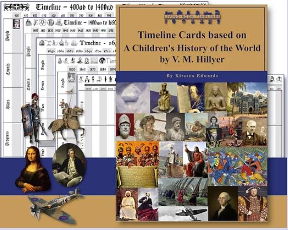Living Book Timelines has created timeline posters and images (called cards) that correlate with The Story of the World series by Susan Wise Bauer, A Child’s History of the World by V. M. Hillyer, Trial and Triumph by Richard Hannula (church history through biographies), This Country of Ours by H.E. Marshall (U.S. history), and Our Island Story by H.E. Marshall (the history of England).
The same timeline is used for all of the different books, but individual collections of images are designed particularly for each resource. The images are arranged as rows of rectangular cards (1.5 x 2 inches each) that students will cut apart and affix to the sections of the timeline.
The timeline itself is divided into five different eras with a poster for each: Ancient Times, Middle Ages, Reformation/Renaissance, Early Modern, and Modern. With this division into five eras, you can display only the section of the timeline that is pertinent to your studies.
Each era is divided into four “strands” with a row for each: people, events, wars, and progress. This arrangement allows cards for simultaneous events that fit under the different headings to be affixed at the same point on the timeline. Timelines from 1400 AD to the present add a second group of four rows at the bottom where you can include events from the history of your country (U.S. or other country). Those rows are condensed to about half the height of the rows for world history, so it might be tight if you try to fit many images into those areas. For instance, you’ve got just a few square inches available for the time period of the U.S. Civil War. So you will want to use a different timeline if you are studying your country’s history in depth.
The images on the cards are printed in either black and white or color, and they include dates and brief captions. The cards also indicate the chapters with which the images correlate. For The Story of the World, there are four collections of timeline images (with over 600 images in all), while there is only one collection of images for each of the other history books since they are single-volume histories.
The style of the artwork on the images varies greatly since they were created from public domain sources featuring paintings, sculptures, drawings, architecture, and photographs. Free blank templates are available for creating your own images if you want to add more.
All of the timeline components are sold as downloadable files, and they include files that will work in different countries as well as files for the timelines that can be printed on a normal home printer or files that can be printed directly on a large poster (probably by a print shop). If you print timeline files yourself, you will probably need to cut and tape them together. Instructions that come with the timelines help you determine which files to print. The timelines are in black and white, while the pages with the images need to be printed in color.
There are many options for timelines, but the Living Book Timelines are the first I recall seeing with downloadable versions that take into account the needs of homeschoolers living in countries all over the world.









